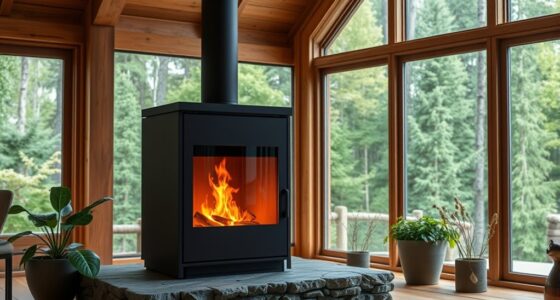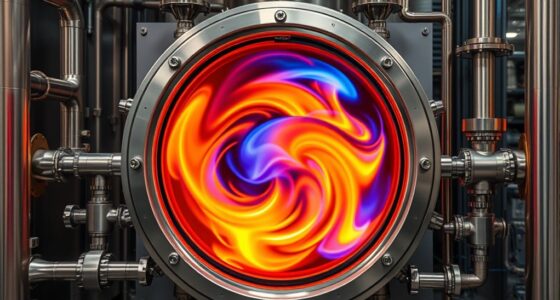Efficient burning occurs when you optimize fuel combustion, ensuring it burns completely with the right air-to-fuel ratio. This process minimizes unburned hydrocarbons, carbon monoxide, and soot, leading to fewer harmful emissions. By controlling temperature and oxygen levels, you can reduce pollutant release and improve environmental quality. Keeping your systems well-maintained boosts efficiency even further. Explore how these strategies work together to help you cut emissions and protect the planet.
Key Takeaways
- Complete combustion minimizes unburned hydrocarbons and carbon monoxide, reducing harmful emissions.
- Proper air-to-fuel ratio ensures optimal burning, decreasing soot and toxic gases.
- Monitoring and adjusting combustion parameters maintain stable, efficient flames and lower pollutant release.
- Using emission control devices and feedback systems further reduce pollutants generated during burning.
- Efficient burning wastes less fuel, decreasing overall emissions and environmental impact.

Efficient burning is essential for reducing harmful emissions and maximizing energy use. When you focus on combustion optimization, you ensure that fuel is burned thoroughly and efficiently, which directly impacts the amount of pollutants released into the environment. Proper combustion means having the right air-to-fuel ratio and maintaining ideal temperature levels, so the process produces fewer unburned hydrocarbons, carbon monoxide, and other harmful substances. By fine-tuning your combustion process, you can substantially decrease the pollutants generated, leading to cleaner emissions and a smaller environmental footprint. Implementing vetted combustion techniques further enhances pollutant reduction and system performance. Pollutant control becomes much more manageable when you implement strategies that promote complete combustion. Incomplete combustion not only wastes fuel but also produces excess smoke, soot, and toxic gases. These emissions contribute to air pollution, smog formation, and health problems. When you optimize your combustion process, you reduce these risks because less unburned fuel remains, and the formation of harmful byproducts is minimized. This is especially critical in industrial settings, power plants, and residential heating systems, where large volumes of fuel are burned daily. The key is to maintain stable flame conditions, monitor oxygen levels, and adjust burner settings regularly to keep combustion efficient. Additionally, adopting advanced control systems can help maintain optimal combustion conditions more consistently. Incorporating real-time data monitoring allows operators to respond quickly to any deviations from ideal combustion parameters. Implementing automated sensors and feedback loops can further refine the process, reducing variability in emissions and improving overall performance. Moreover, embracing combustion optimization techniques allows you to control pollutants more effectively. For example, implementing advanced control systems, such as automated sensors and feedback loops, ensures that combustion conditions stay within ideal parameters. This not only reduces emissions but also improves overall system performance and energy efficiency. Proper pollutant control through optimized combustion also helps you meet strict environmental regulations and standards, avoiding penalties and promoting corporate responsibility. In addition, cleaning and maintaining burners and combustion chambers prevent the buildup of residues that could disrupt the process or cause incomplete burning. Regular inspections help you identify issues early, ensuring that the system operates at peak efficiency. Installing emission control devices, like scrubbers or catalytic converters, further minimizes the release of hazardous pollutants into the atmosphere. All these measures combined amplify the benefits of combustion optimization, making your operations cleaner, safer, and more sustainable. Ultimately, focusing on efficient burning through combustion optimization and pollutant control isn’t just about complying with regulations. It’s about actively reducing your environmental impact, saving costs on fuel, and promoting a healthier planet. When you prioritize these practices, you contribute to cleaner air and a more sustainable future while reaping the benefits of improved system performance and reduced operational expenses.
Frequently Asked Questions
What Types of Fuels Benefit Most From Efficient Burning Techniques?
You’ll find that biomass applications, like wood and agricultural waste, benefit most from efficient burning techniques since they produce fewer emissions and maximize energy output. Fossil fuels such as coal and natural gas also see significant improvements through optimization, reducing harmful pollutants. By focusing on these fuels, you can lower environmental impact, make energy production more sustainable, and save costs, all while improving overall combustion efficiency.
How Does Efficient Burning Impact Overall Energy Costs?
Efficient burning substantially lowers your overall energy costs by improving fuel economy and reducing waste. When you optimize combustion, you use less fuel for the same energy output, leading to cost savings over time. This not only cuts expenses but also extends equipment lifespan and minimizes maintenance needs. Consequently, investing in efficient burning methods makes your energy consumption more economical, helping you save money while supporting environmental sustainability.
Are There Specific Technologies That Enhance Burning Efficiency?
You can boost burning efficiency with technologies like combustion optimization, which fine-tunes fuel and air mix for complete burn, and emission control systems that reduce pollutants. While traditional burners work, advanced sensors and automated controls allow precise adjustments, minimizing waste and emissions. These innovations work together, ensuring cleaner combustion, lower emissions, and better energy use, proving that upgrading technology directly impacts environmental and operational performance.
What Are Common Barriers to Implementing Efficient Burning Practices?
You might face barriers like strict burning regulations that limit flexibility and compliance costs. Fuel subsidies can favor cheaper, less efficient fuels, discouraging investment in cleaner burning technologies. Additionally, lack of awareness or training hampers proper burning practices. Overcoming these obstacles requires policy adjustments, incentivizing efficient burning, and educating operators to prioritize emission reductions, ultimately making it easier to adopt more sustainable practices.
How Quickly Can Emission Reductions Be Observed After Improving Burning Efficiency?
Think of your burning process as a well-tuned orchestra; as soon as you improve the burning cycle, instant emission changes occur. You’ll see cleaner air practically immediately, sometimes within hours or days. These quick results happen because burning cycle improvements optimize fuel use, reducing pollutants right away. So, by fine-tuning your process, you’re not only enhancing efficiency but also making a swift impact on emission levels.
Conclusion
By choosing efficient burning practices, you become a guardian of the environment, turning small actions into mighty waves of change. Remember, each clean burn is a brushstroke on the canvas of our planet’s future. Like a single drop creating ripples, your efforts can inspire others to follow suit. Embrace efficiency, and watch as your choices transform into a powerful force for cleaner air and a healthier Earth—because, in the end, every effort counts.











